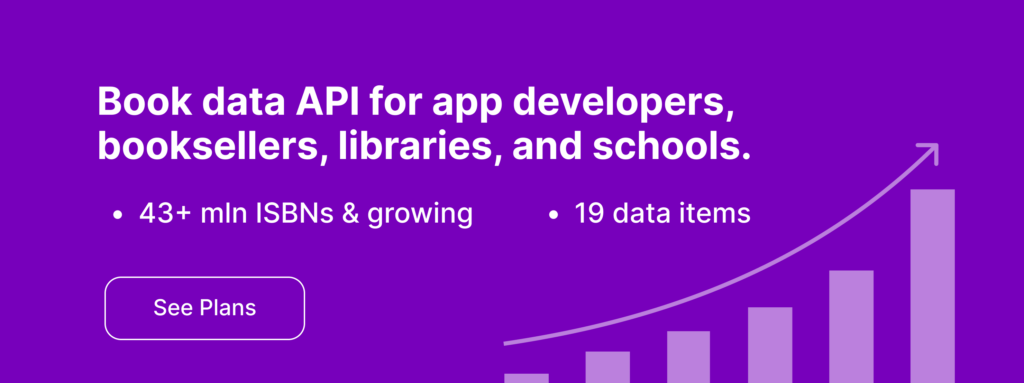
Just because the world is becoming more digital doesn’t mean that books have become irrelevant. Digitalization has helped make millions of books more readily available to billions of people.
Indeed, the “digital shift” has sparked a surge in the development of book-related APIs, which are now recognized as crucial tools for accessing a wealth of book metadata, from titles and author names to ISBNs and summaries. Still, among the most sought-after functionalities of these APIs is the ability to retrieve book cover images.
A reliable API can be invaluable if you are developing a book recommendation engine, a search tool, or an application to enhance reading experiences.
This blog post’ll explore the top five APIs for sourcing book cover images while discussing their broader role in the tech-savvy world of book lovers and publishing professionals.
What are Book APIs?
Book APIs, or Application Programming Interfaces, act as bridges, allowing developers to tap into extensive book-related data provided by various services. More specifically, APIs facilitate interaction with book databases, which are large repositories containing detailed information about books, including titles, authors, genres, and cover images.
APIs are also crucial to simplifying the development of book-related apps. This could refer to any software for reading, reviewing, buying, or managing book collections. Though each one is different in its way, most APIs accomplish this by providing pre-defined methods to access and manipulate data stored in these databases.
Because they accelerate development while ensuring consistent and secure data handling, APIs have become essential to linking developers with the tools they need to create dynamic and engaging book-related apps.
Why Are Cover Images So Important?
For over 100 years, book images have been critical in how readers interact with written content. Despite the undeniable magic of typesetting, most people are opposed to vast text blocks that lack any visual anchor.
Book covers provide that visual element. Even when searching online, a book cover is often the first thing a potential reader sees. Time and time again, a visually appealing cover has been proven to help books stand out in a crowded app or database, attracting attention and encouraging users to learn more about the book.
On digital platforms, where users often scroll through large volumes of content quickly, book covers serve as a vital visual element. Without that critical anchor, app users would be treated to an unattractive and hard-to-process text block. Even if the cover image is less than exciting, it is still a functional asset that enhances discoverability, engagement, and the overall user experience.
Top 5 APIs for Sourcing Book Covers
 1. Bookshare API
1. Bookshare API
Bookshare provides a unique library service, as it is particularly aimed at individuals with disabilities. Nonetheless, the API excels in providing both textual content and cover images, which are crucial for users to identify and select books visually.
The API facilitates access to a global online library where developers can search for books by various criteria, including author and title, and instantly retrieve metadata along with the book cover. This feature is especially beneficial for creating apps that cater to visually impaired users, allowing for a more inclusive reading environment.
However, to access these features, developers must apply for an application key tailored to their specific device requirements.
 2. Open Library
2. Open Library
Backed by the Internet Archive, the Open Library API provides a comprehensive digital library with information on millions of books. More importantly, it offers developers the ability to retrieve detailed book records, including cover images.
The Open Library also makes it very easy to integrate book covers into applications by providing URLs to high-quality images in their API responses. This functionality supports a variety of uses, from displaying cover art in a digital bookstore to enhancing bibliographic databases with visual identifiers.
 3. Google Books API
3. Google Books API
The Google Books API is a robust tool offering access to the internet’s largest collection of digital books. One of the standout features of this API is its ability to provide multiple links to book cover images through its imageLinks attribute, which includes various sizes from thumbnails to extra-large images.
This flexibility allows developers to choose the appropriate image size for their application’s layout and design needs. Google Books also supports a preview feature, which allows users to view covers within the context of the book’s content, enhancing the browsing and shopping experience on book-related applications.
 4. Internet Archive API
4. Internet Archive API
The Internet Archive API extends beyond just books, including a vast repository of media and texts and a significant number of book titles. Of course, the API also provides access to cover images by linking directly to scans of the books available in their collection.
Developers can easily use this API to incorporate book covers into applications that catalog historical, rare, or out-of-print books, providing a visual element that enriches the user’s exploration of both old and rare literature.
 5. ISBNdb API
5. ISBNdb API
ISBNdb is a comprehensive source for book data, and its API offers detailed information on over 43 million titles. Most importantly, it’s very easy to find cover images, including both current and past cover designs.
Developers can access virtually everything they need with just a book’s ISBN, making it incredibly efficient for applications that link metadata with visual representations. Such data points are essential for sales and inventory management applications, where visual confirmation can make all the difference.
Conclusion
The APIs discussed here represent just a slice of what’s available. Still, they are among the most versatile and valuable for anyone looking to enhance their applications with rich book data. Whether you’re building for a niche audience or a broad user base, these APIs provide the tools you need to succeed, particularly when it comes to including cover images.






